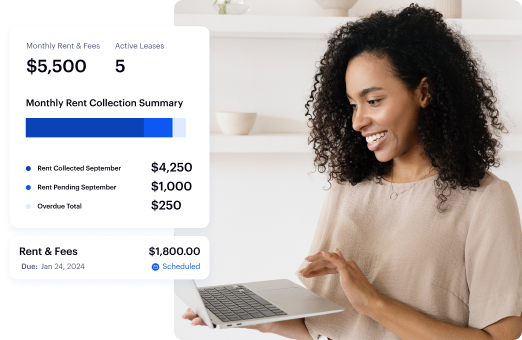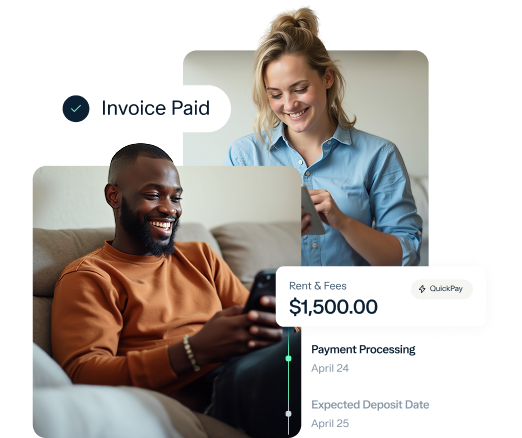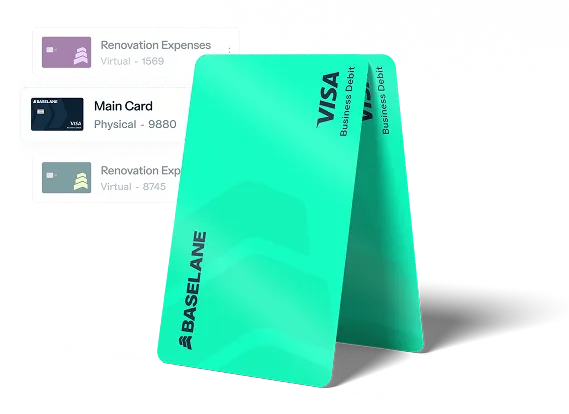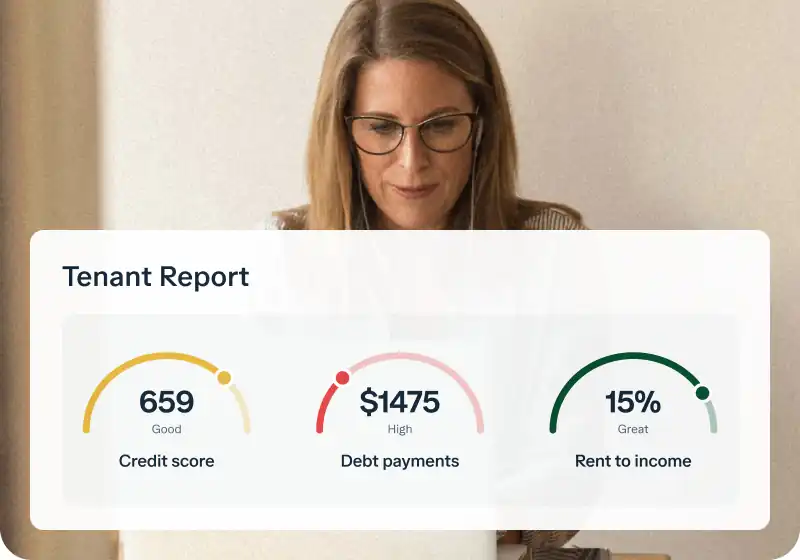Managing rental property finances efficiently is crucial for every landlord. As electronic payments become the standard, understanding the nuances between options like eChecks and Automated Clearing House (ACH) payments can significantly impact your operations.
This guide explores the key differences, helping you choose the best payment methods for your rental business. By streamlining your rent collection, you can save time, gain clarity, and grow your passive income.
Key takeaways
- For recurring rent, choose ACH over eChecks; it offers superior security (Nacha-governed), faster processing (1–3 days), and lower costs, which is crucial for predictable cash flow.
- eChecks are better suited for one-time, large transactions like a security deposit, functioning as a digital stand-in for a paper check.
- Automated ACH transfer eliminates manual rent chasing and is the most efficient way to manage rent payments across multiple properties.
- Baselane integrates automated ACH collection directly with dedicated checking and savings accounts and bookkeeping to simplify rent collection and increase visibility.
What is an eCheck?
An eCheck is simply a digital version of a paper check. It facilitates payments directly from a tenant's bank account to a landlord's account by using existing checking account and routing information to process the transaction electronically.
When a tenant uses an eCheck, the payment is processed through a gateway that converts the information into an electronic transaction, often requiring a digital signature or consent.
- How it works: The tenant creates a digital representation of a check for processing and offers it to the bank or uploads it using an online payment solution.
- Best for: One-time or larger payments, such as a security deposit or a one-time fee.
- Security: Generally considered secure, leveraging encryption, but may carry a slightly higher fraud risk due to the nature of digital check fraud.
What is an ACH payment?
An ACH payment uses the Automated Clearing House (ACH) network , which is a vast electronic funds transfer system in the U.S. This network processes large volumes of credit and debit transactions, governed by specific rules and regulations enforced by Nacha. The ACH network is a foundation of modern real estate financial management.
- How it works: Payments are processed in batches, typically overnight, as direct bank-to-bank transfers. Learn more about how the automated clearing house payment system works.
- Best for: Automated recurring transactions, making it the top choice for rent collection due to its convenience and predictability.
- Security: Highly secure with comprehensive fraud monitoring systems enforced by Nacha's strict rules, which is vital for bank-to-bank transfers
ACH vs. eCheck: Processing fees, time, and security
Understanding the practical differences in processing fees, time, and security is essential for choosing the best solution to collect rent and minimize financial risk.
Processing fees
- ACH payments are processed in batches, which leads to lower processing fees, often ranging between $0.15 - $0.50 per transaction.
- eCheck fees are often similar to ACH, ranging between $0.10 - $1.00 per transaction. Some eCheck services, however, might charge slightly higher costs due to additional verification steps involved.
Processing time
ACH payments are generally faster and more predictable for landlords.
- Standard ACH: Settles in 1–3 business days.
- Same-day ACH services are available for a fee, settling payments in as little as one business day.
- eCheck: Takes comparatively longer to process, usually settling within 3–5 business days. This longer period can cause minor delays in accessing your rental income
Security
For maximum security and compliance, ACH is the preferred method.
- ACH payment: Governed by Nacha, which enforces strict rules and comprehensive fraud monitoring systems. The regulatory oversight makes it a highly secure method for bank-to-bank transfers.
- eCheck: Employs strong security protocols like digital signatures and encrypted data. However, the process carries a slightly higher risk of digital check fraud due to the exposure of bank account details.
When should you use eCheck vs. ACH as a landlord?
eChecks are ideal for:
- One-time payments
- Large payments
- Collecting security deposits
- Collecting one-time charges
- Situations where a digital substitute for a physical check is needed
ACH payments are ideal for:
- Automated recurring rent collection, especially when you manage multiple properties
- Setting up regular, scheduled debits
- Ensuring consistent cash flow without manual intervention
Why ACH payments are preferred for rent collection
ACH’s lower-cost and strong security measures make it a preferred method for landlords to collect rent. In fact, 60% of the tenants typically pay rent online, while 69% would prefer to consider this option, as per Zillow’s Consumer Housing Trends Report 2024. And, by offering ACH to such huge base of tenants, you can ensure timely payments and better tenant relationships.
Here are some other benefits that make ACH one of the best ways to collect rent online.
- Reliable, on-time payments: ACH allows you to set up recurring, scheduled debits from tenant accounts, providing unparalleled convenience and predictability. You'll see fewer late payments and a more consistent cash flow.
- Time savings: For landlords managing multiple properties, the efficiency of automated ACH payments is a massive time saver, ensuring consistent cash flow without manual intervention.
- Security & compliance: The strict regulatory framework set by Nacha helps maintain security and reduce fraud, giving you peace of mind.
- Cost-effectiveness: The lower processing fees associated with ACH make it an economical choice for the recurring nature of rent payments.
Baselane's banking platform is purpose-built for investors and landlords like you to help you unlock the benefits of ACH payments through a range of features.
- Flexible payments: Offer tenants multiple options, including free ACH payments (when you receive funds in a Baselane account), to ensure convenience.
- Automate rent collection: Set up automated rent collection and reminders to schedule invoices, automatically apply late fees, and ensure reliable, on-time payments.
- Flexible rent options: Tenant split rent payments with Flex Rent, which allows multiple tenants to use apps to split rent payments.
- Organized finances: Open unlimited checking and high-yield savings accounts for each property and entity. This helps you maintain a clear separation of funds, preventing commingling and simplifying tax time.
- Fast payouts: Receive your rent money in as little as 2-5 days with QuickPay.
- Grow passive income: Maximize your earnings by collecting rent directly into a Baselane Savings account, where you can earn up to [v="apyvalue"] APY² on deposits.
How to set up ACH for rent collection: A step-by-step guide
Follow these steps to set up ACH and start collecting rent payments hassle-free.
- Step 1: Obtain authorization from your tenant. This typically involves a written agreement allowing you to debit their bank account. The authorization should include the payment amount, frequency, and duration.
- Step 2: Gather tenant's banking details, including their bank account number and ACH routing number. This is important to initiate the electronic transfer.
- Step 3: Input bank details into your rent payment software or banking platform like Baselane. Services like Baselane allow you to easily send ACH payment instructions. This integration simplifies the entire process.
- Step 4: Schedule the recurring payments according to your lease agreement. Automated systems will then initiate debits on the specified due dates. This setup helps you collect rent reliably and efficiently.
To make this process even simpler, set up multiple bank accounts for each property. This way, you can track rent for each property in a dedicated account, giving you a clear trail of money flowing in every month.
Navigating ACH payments: Common issues and legal compliance
While ACH is secure, there are still potential issues and legal requirements you should know about to succeed with this payment method.
Common ACH issues and how to handle them
Electronic payment methods may occasionally encounter challenges. A robust, integrated system helps you handle them smoothly.
- Failed payments and non-sufficient funds (NSF): Failed payments can result from incorrect bank information or expired authorizations. NSF occurs when a tenant's account lacks sufficient funds, which may result in a fee from your payment processor. To mitigate this, use automated notifications for failed payments and re-attempts. Set clear lease terms outlining the tenant's responsibility for NSF fees.
- Payment reversals: Less common, but can result from unauthorized transactions or disputes. To solve this, maintain thorough records of all transactions and authorization agreements.
Legal considerations for mandating rent payment methods
The ability to mandate eCheck or ACH payments varies by jurisdiction.
- Check local laws: Some local and state laws may require you to accept traditional payment forms like physical checks or cash.
- Clarity is key: Always clearly outline all accepted payment methods in the lease agreement to manage tenant expectations and avoid disputes.
- Preferred vs. mandated: While ACH is your preferred option for convenience and cost, you may need to retain a policy that allows tenants to use other legally accepted methods.
Start using ACH for rent collection
Bottom line here is simple: ACH is a much efficient choice to collect rent. It’s faster, more secure, and cheaper for recurring payments, especially when you manage multiple rental properties. eChecks, while being cost-efficient, come with a higher risk of digital fraud, impacting your cash flow.
Baselane wraps automated ACH rent collection, dedicated property banking, and effortless bookkeeping all into one platform. This means you don’t need to worry about manual data entry or spend hours chasing rent payments. You get money into a dedicated bank account, charge a late fee automatically, and keep tenants in the loop. Create your free Baselane account today and simplify rent collection!
FAQs
What is the primary difference between an eCheck and an ACH payment?
The main difference between an eCheck and an ACH payment lies in their processing and regulatory framework. An eCheck is a digital version of a paper check, while an ACH payment processes directly through the Automated Clearing House network.
How long does it take for ACH payments to process for rent?
ACH payments typically process and settle in 1–3 business days. This efficient timeline ensures that landlords receive their rent income promptly. Same-day ACH options are also available, often for an additional fee.
Can landlords mandate eCheck or ACH payments from tenants?
The ability to mandate eCheck or ACH payments varies by jurisdiction. Some local and state laws may require landlords to accept traditional payment methods like physical checks or cash. Always consult your local regulations to ensure compliance.
Are eChecks or ACH payments more secure for rental transactions?
ACH payments are generally considered more secure due to the stringent rules and fraud monitoring enforced by Nacha. eChecks also use encryption, but they may carry a slightly higher risk related to digital check fraud. Both methods are safer than traditional paper checks.
How can landlords receive ACH payments into their bank account?
Landlords can receive ACH payments by setting up a reliable rent collection system or using a banking platform that supports ACH. Tenants authorize direct debits from their accounts, and the funds are then transferred electronically. Learn more about how to receive ACH payment into your bank account.

















